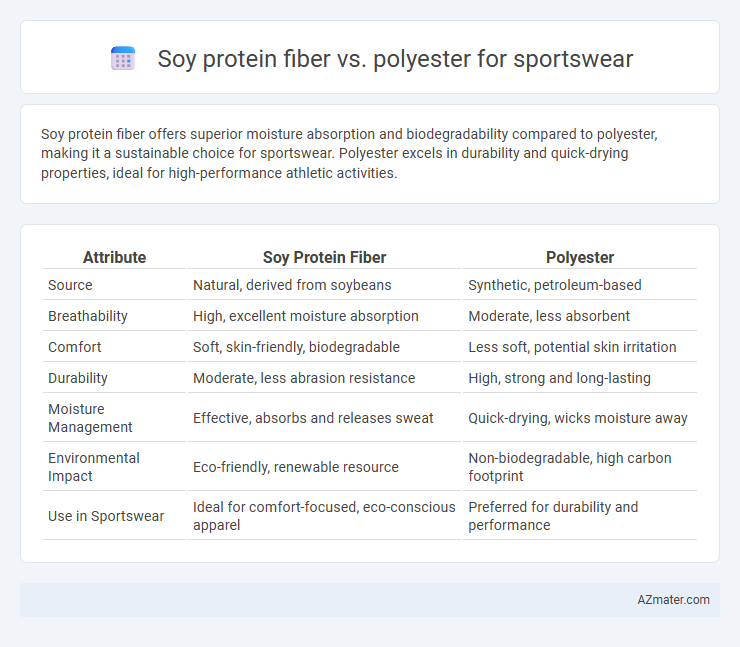Soy protein fiber offers superior moisture absorption and biodegradability compared to polyester, making it a sustainable choice for sportswear. Polyester excels in durability and quick-drying properties, ideal for high-performance athletic activities.
Table of Comparison
| Attribute | Soy Protein Fiber | Polyester |
|---|---|---|
| Source | Natural, derived from soybeans | Synthetic, petroleum-based |
| Breathability | High, excellent moisture absorption | Moderate, less absorbent |
| Comfort | Soft, skin-friendly, biodegradable | Less soft, potential skin irritation |
| Durability | Moderate, less abrasion resistance | High, strong and long-lasting |
| Moisture Management | Effective, absorbs and releases sweat | Quick-drying, wicks moisture away |
| Environmental Impact | Eco-friendly, renewable resource | Non-biodegradable, high carbon footprint |
| Use in Sportswear | Ideal for comfort-focused, eco-conscious apparel | Preferred for durability and performance |
Introduction to Soy Protein Fiber and Polyester in Sportswear
Soy protein fiber, derived from natural soybeans, offers breathable, moisture-wicking, and biodegradable qualities ideal for sustainable sportswear. Polyester, a synthetic polymer widely used in sports apparel, provides durability, elasticity, and quick-drying properties, enhancing athletic performance. Both materials serve distinct roles in sportswear design, balancing eco-friendly attributes with functional demands.
Environmental Impact: Soy Protein Fiber vs. Polyester
Soy protein fiber offers a biodegradable and renewable alternative to polyester, which is derived from non-renewable petroleum and contributes to significant carbon emissions. Polyester production involves high energy consumption and generates microplastic pollution, posing long-term environmental hazards in aquatic ecosystems. In contrast, soy protein fiber decomposes naturally, reducing landfill waste and minimizing ecological footprints associated with sportswear manufacturing.
Moisture-Wicking Abilities Compared
Soy protein fiber exhibits superior moisture-wicking capabilities due to its natural hydrophilic properties, enabling efficient absorption and quick evaporation of sweat during intense physical activities. Polyester, widely used in sportswear, offers excellent moisture management by rapidly moving perspiration away from the skin to the fabric surface where it evaporates, promoting dryness. However, soy protein fiber provides enhanced breathability and softness, making it a comfortable alternative for athletes seeking natural, moisture-wicking materials.
Comfort and Skin Sensitivity
Soy protein fiber offers superior breathability and moisture-wicking properties, making it ideal for sportswear that prioritizes comfort during intense workouts. Its natural composition reduces the risk of skin irritation and allergies, providing a hypoallergenic alternative to synthetic polyester. Polyester, while durable and quick-drying, may trap heat and cause discomfort or sensitivity in individuals with sensitive skin.
Breathability and Temperature Regulation
Soy protein fiber offers superior breathability compared to polyester, enabling better moisture absorption and wicking to keep athletes dry during intense workouts. Its natural properties promote enhanced temperature regulation by allowing air circulation and reducing heat retention, which helps maintain comfort in varying conditions. Polyester, while durable and quick-drying, tends to trap heat and moisture, making it less effective for breathability and temperature control in high-performance sportswear.
Durability and Longevity
Soy protein fiber offers breathability and biodegradability but tends to have lower abrasion resistance compared to polyester, making it less durable for intense sportswear use. Polyester exhibits superior tensile strength, moisture-wicking properties, and resistance to UV and chemical degradation, enhancing its longevity in activewear. Athletes often prefer polyester for its ability to maintain shape and durability through repeated wash cycles and rigorous physical activities.
Odor Resistance in Sports Activities
Soy protein fiber exhibits superior odor resistance in sportswear compared to polyester due to its natural antimicrobial properties that inhibit odor-causing bacteria during intense physical activities. Polyester, while durable and moisture-wicking, tends to retain odors after repeated use because its synthetic fibers trap sweat and bacteria more effectively. Choosing soy protein fiber in sports apparel enhances freshness and comfort by reducing odor buildup, making it favorable for athletes engaged in prolonged or high-intensity exercise.
Sustainability and Biodegradability
Soy protein fiber, derived from renewable soybean sources, offers superior sustainability and biodegradability compared to polyester, which is petroleum-based and non-biodegradable. Soy protein fiber decomposes naturally within months, reducing environmental impact and landfill waste, while polyester can persist for decades. The eco-friendly profile of soy protein fiber aligns with growing consumer demand for sustainable sportswear materials.
Cost-Effectiveness and Accessibility
Soy protein fiber offers a sustainable alternative to polyester in sportswear, often boasting better moisture absorption and biodegradability, but typically comes at a higher production cost. Polyester remains more cost-effective due to its widespread availability, lower manufacturing expenses, and established supply chains, making it more accessible for mass-market sportswear brands. Brands seeking eco-friendly yet affordable sportswear must balance the premium price of soy protein fiber against polyester's cost advantages and performance characteristics.
Future Trends in Sportswear Fabrics
Soy protein fiber, derived from renewable soybeans, offers exceptional moisture-wicking and biodegradable properties, making it a sustainable alternative to conventional polyester in sportswear. Polyester, known for its durability, elasticity, and moisture management, remains dominant but faces increasing scrutiny due to environmental concerns and microplastic pollution. Future trends indicate a growing shift towards bio-based fibers like soy protein fiber, combined with recycled polyester blends, to create high-performance, eco-friendly sportswear that aligns with sustainability goals and consumer demand for greener apparel.

Infographic: Soy protein fiber vs Polyester for Sportswear
 azmater.com
azmater.com